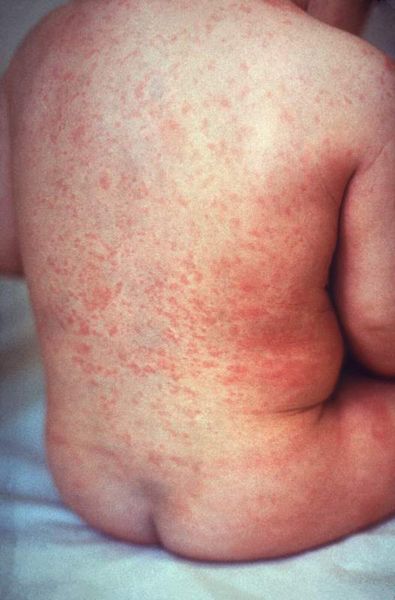Rubella
For patient information click here
| Rubella | |
 | |
|---|---|
| ICD-10 | B06 |
| ICD-9 | 056 |
| DiseasesDB | 11719 |
| MedlinePlus | 001574 |
|
Rubella Microchapters |
|
Diagnosis |
|---|
|
Treatment |
|
Case Studies |
|
Rubella On the Web |
|
American Roentgen Ray Society Images of Rubella |
Editor-In-Chief: C. Michael Gibson, M.S., M.D. [1]
Overview
Historical Perspective
Pathophysiology
Epidemiology & Demographics
Risk Factors
Screening
Causes
Differentiating Rubella
Complications & Prognosis
Diagnosis
History and Symptoms | Physical Examination | Laboratory tests | Electrocardiogram | X Rays | CT | MRI Echocardiography or Ultrasound | Other images | Alternative diagnostics
Treatment
Medical therapy | Surgical options | Primary prevention | Secondary prevention | Financial costs | Future therapies
Epidemiology
Rubella is a disease that occurs worldwide. The virus tends to peak during the spring in countries with temperate climates. Before the vaccine to rubella was introduced in 1969, widespread outbreaks usually occurred every 6-9 years in the United States and 3-5 years in Europe, mostly affecting children in the 5-9 year old age group.[1] Since the introduction of vaccine, occurrences have become rare in those countries with high uptake rates. However, in the UK there remains a large population of men susceptible to rubella who have not been vaccinated. Outbreaks of rubella occurred amongst many young men in the UK in 1993 and in 1996 the infection was transmitted to pregnant women, many of whom were immigrants and were susceptible. Outbreaks still arise, usually in developing countries where the vaccine is not as accessible.[2]
During the epidemic in the US between 1962-1965, Rubella virus infections during pregnancy were estimated to have caused 30,000 still births and 20,000 children to be born impaired or disabled as a result of CRS.[3][4] Universal immunisation producing a high level of herd immunity is important in the control of epidemics of rubella.[5]
See also
References
- ↑ Reef SE, Frey TK, Theall K; et al. (2002). "The changing epidemiology of rubella in the 1990s: on the verge of elimination and new challenges for control and prevention". JAMA. 287 (4): 464–72. PMID 11798368.
- ↑ Reef S (2006). "Rubella mass campaigns". Curr. Top. Microbiol. Immunol. 304: 221–9. PMID 16989272.
- ↑ Plotkin SA (2001). "Rubella eradication". Vaccine. 19 (25–26): 3311–9. PMID 11348695.
- ↑ Cooper,L.Z. Congenital Rubella in the United States. 1975 In: Krugman,S Gershon,A (eds), Symposium on Infections Of the Fetus and Newborn Infant. New York, Alan R. Liss Inc.,p.1.
- ↑ Danovaro-Holliday MC, LeBaron CW, Allensworth C; et al. (2000). "A large rubella outbreak with spread from the workplace to the community". JAMA. 284 (21): 2733–9. PMID 11105178.
External links
- Rubella at Wong's Virology.
- Immunization Action Coalition: Rubella
- Template:DermNet
Template:Viral diseases Template:Exanthema
bg:Рубеола cs:Zarděnky de:Röteln eo:Rubeolo fa:سرخجه fi:Vihurirokko he:אדמת id:Rubela it:Rosolia la:Rubella lb:Riselen ms:Penyakit Rubela nl:Rodehond no:Røde hunder simple:Rubella sv:Röda hund th:โรคหัดเยอรมัน